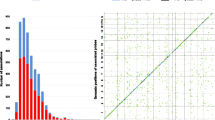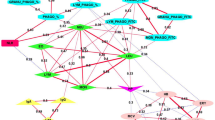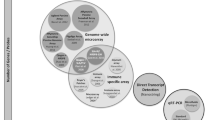Abstract
It is well known that the estrogen receptor alpha gene (ESR1) affects the reproductive traits of pigs; however, the immune role of ESR1 gene has not yet been resolved. Here, we characterized the pleiotropic aspects of ESR1 gene in immunity using the pig model. Tissue expression profile showed that the ESR1 gene had a broad ectopic expression in multiple reproductive and immune-related tissues/organs, which provided the tissue-level spatial fundamental of ESR1 gene that might function as a pleiotropic immune regulator. Using the peripheral blood cell model, a coupling transcriptome analytical strategy was proposed and verified that there existed strong positive or negative correlations of ESR1 gene with hundreds of differentially expressed genes that were involved in the immune regulation, indicating that the ESR1 gene might affect or be affected by, directly or indirectly, dozens of immune-related genes in the peripheral blood cells. Furthermore, the results of genetic association analysis showed that the SmaI-polymorphism of ESR1 gene had significant or highly significant associations with multiple immune traits, including platelet (PLT), hematocrit (HCT), the number of CD4-CD8-CD3- cells, plateletcrit (PCT), mean corpuscular volume (MCV), and mean corpuscular hemoglobin concentration (MCHC). Multiple evidences supported the immune pleiotropic roles of ESR1 gene in pigs. The study advances our understanding of the cross-species immune pleiotropic landscape of ESR1 gene and also provides a potential pleiotropic molecular marker for disease-resistant breeding in pigs.




Similar content being viewed by others
References
Burns KA, Korach KS (2012) Estrogen receptors and human disease. Arch Toxicol 86(10):1491–1504
Carreras E, Turner S, Frank MB et al (2010) Estrogen receptor signaling promotes dendritic cell differentiation by increasing expression of the transcription factor IRF4. Blood 115:238–246
Chapman JC, Chapman FM, Michael SD (2015) The production of alpha/beta and gamma/delta double negative (DN) T-cells and their role in the maintenance of pregnancy. Reproductive Biology and Endocrinology 13(1):73
Cuzzocrea S, Genovese T, Mazzon E, Esposito E, Paola RD, Muià C, Crisafulli C, Peli A, Bramanti P, Chaudry IH (2008) Effect of 17beta-estradiol on signal transduction pathways and secondary damage in experimental spinal cord trauma. Shock 29(3):362–371
Dai R, Phillips RA, Zhang Y, Khan D, Crasta O, Ahmed SA (2008) Suppression of LPS-induced Interferon-gamma and nitric oxide in splenic lymphocytes by select estrogen-regulated microRNAs: a novel mechanism of immune modulation. Blood 112(12):4591–4597
Deena, Khan, S, Ansar, Ahmed (2016) The immune system is a natural target for estrogen action: opposing effects of estrogen in two prototypical autoimmune diseases. Frontiers in Immunology 6:635
Fish EN (2008) The X-fifiles in immunity: sex-based differences predispose immune responses. Nat Rev Immunol 8:737–744
Fuseini H, Cephus JY, Wu PS et al (2019) ERα signaling increased IL-17A production in Th17 cells by upregulating IL-23R expression, mitochondrial respiration, and proliferation. Frontiers in Immunology 10:2740
Gloria M, Cristina O, Jordi E, Luis S, Almudena F, Rodriguez C (2007) Association with litter size of new polymorphisms on ESR1 and ESR2 genes in a Chinese-European pig line. Genetics Selection Evolution 39:195–206
Goldberg J, Qiao N, Gross B, Meric-Bernstam F, Guerriero J, Chen K, Philips AV, Peoples GE, Alatrash G, Mittendorf EA (2020) ESR1 mutations provide novel targets for breast cancer immunotherapy. Journal of Clinical Oncology 38(15): suppl3135.
Hamilton KJ, Hewitt SC, Arao Y, Korach KS (2017) Estrogen hormone biology. Current Topics in Developmental Biology 109.
Hayes SM, Li L, Love PE (2005) TCR signal strength influences alphabeta/gammadelta lineage fate. Immunity 22(5):583
Jeselsohn R, Buchwalter G, Angelis CD, Brown M, Schiff R (2015) ESR1 mutations as a mechanism for acquired endocrine resistance in breast cancer. Nature Reviews Clinical Oncology 12(10):573
Kadel S, Kovats S (2018) Sex hormones regulate innate immune cells and promote sex differences in respiratory virus infection. Frontiers in Immunology 9:1653
Khan D, Cowan C, Ahmed SA (2012) Estrogen and signaling in the cells of immune system. Advances in Neuroimmune Biology 3(1):73–93
Komi J, Lassila O (2000) Nonsteroidal anti-estrogens inhibit the functional differentiation of human monocyte-derived dendritic cells. Blood 95:2875–2882
Kovats and Susan (2012) Estrogen receptors regulate an inflflammatory pathway of dendritic cell differentiation: Mechanisms and implications for immunity. Horm Behav 62:254–262
Kovats S, Carreras E, Agrawal H (2010) Sex steroid receptors in immune cells. In: Klein S, Roberts C (eds) Sex hormones and immunity to infection. Springer, Heidelberg, pp 53–91
Kyuichi K, Takashi E, Jonathan VV, Kaitlin MW, Camelia SS, David RJ, William DT, Prasad SA (2015) Nuclear estrogen receptor-α expression is an independent predictor of recurrence in male patients with pT1aN0 lung adenocarcinomas, and correlates with regulatory T-cell infiltration. Oncotarget 6(29):27505–27518
Laffont S, Seillet C, Guéry JC (2017) Estrogen receptor-dependent regulation of dendritic cell development and function. Frontiers in Immunology 8:108
Li S, Herrera GG, Tam KK, Lizarraga JS, Beedle MT, Winuthayanon W (2018) Estrogen action in the epithelial cells of the mouse vagina regulates neutrophil infiltration and vaginal tissue integrity. Scientific Reports 8(1):11247
Liu HY, Buenafe AC, Matejuk A, Ito A, Zamora A, Dwyer J, Vandenbark AA, Offner H (2002) Estrogen inhibition of EAE involves effects on dendritic cell function. J Neurosci Res 70(2):238–248
Liu W, Shao FM, Yan L, Cao HX, Qiu D (2014) Polymorphisms in the gene encoding estrogen receptor alpha are associated with osteoarthritis in Han Chinese women. International Journal of Clinical & Experimental Medicine 7(12):5772–5777
Lunney JK (2007) Advances in Swine Biomedical Model Genomics. International Journal of Biological Sciences 3(3):179–184
Lu ZM, Wang ZE, Liu YQ, Wu CX, Wang CY, Zhang BC, Shao S, Jiao YL, Che ZX, Chen ZJ, Zhao YR (2009) Association of estrogen receptor alpha gene polymorphisms with cytokine genes expression in systemic lupus erythematosus. Croatian Medical Journal 50(2):117–123
Mering VC (2003) STRING: a database of predicted functional associations between proteins. Nucleic Acids Res 31(1):258–261
Monteiro R, Teixeira D, Calhau C (2014) Estrogen signaling in metabolic inflammation. Mediators of Inflammation 615917
Paskulin DD, CunhaFilho JS, Paskulin LD, Bastos Souza CA, AshtonProlla P (2014) ESR1 rs9340799 is associated with endometriosis-related infertility and in vitro fertilization failure. Dis Markers 35(6):907
Paterni I, Granchi C, Katzenellenbogen JA Minutolo F (2014) Estrogen receptors alpha (ERα) and beta (ERβ) estrogen receptors alpha (ERα) and beta (ERβ): subtype-selective ligands and clinical potential. Steroids 90(13):29
Priyanka HP, Krishnan HC, Singh RV, Hima L, Thyagarajan S (2013) Estrogen modulates in vitro T cell responses in a concentration- and receptor-dependent manner: effects on intracellular molecular targets and antioxidant enzymes. Mol Immunol 56(4):328–339
Recalde G, Moreno-Sosa T, Yúdica F et al (2018) Contribution of sex steroids and prolactin to the modulation of T and B cells during autoimmunity. Autoimmun Rev 17(5):504–512
Rothschild MF, Bidanel JP (1998) Biology and genetics of reproduction. The Genetics of the Pig 313–343
Schomberg DW, Couse JF, Mukherjee A, Lubahn DB, Sar M, Mayo KE, Korach KS (1999) Targeted disruption of the estrogen receptor-alpha gene in female mice: characterization of ovarian responses and phenotype in the adult. Endocrinology 140(6):2733–2744
Shannon P, Markiel A, Ozier O et al (2003) Cytoscape: a software environment for integrated models of biomolecular interaction networks. Genome Res 13(11):2498–2504
Słomiński B, Myśliwska J, Ryba-Stanisławowska M et al (2018) Estrogen receptor α gene polymorphism and vascular complications in girls with type 1 diabetes mellitus. Mol Cell Biochem 437(1):153–161
Robinson DR, Wu YM, Vats P et al (2013) Activating ESR1 mutations in hormone-resistant metastatic breast cancer. Nat Genet 45(12):1446-U197
Rybastanisławowska M, Rybarczykkapturska K, Brandt A, Myśliwiec M, Myśliwska J (2014) IVS1−397TC estrogen receptor polymorphism is associated with low-grade systemic inflammatory response in type 1 diabetic girls. Mediators of Inflammation 839585.
Wang JY, Wang YP, Wang HZ, Wang HF, Liu JF, Wu Y, Guo JF (2016) Transcriptomic analysis identifies candidate genes and gene sets controlling the response of porcine peripheral blood mononuclear cells to poly I:C stimulation. G3 (Bethesda, Md) 6(5):1267–1275.
Wedrén S, Lovmar L, Humphreys K et al (2008) Estrogen receptor alpha gene polymorphism and endometrial cancer risk–a case-control study. BMC Cancer 8(1):322
Yin XQ, Ju HM, Guo Q, Zhao L, Zhu XX, Wei R, Zhang Z, Zhang YH, Wang B, Li X (2018) Association of estrogen receptor 1 genetic polymorphisms with recurrent spontaneous abortion risk. Chin Med J 131(15):1857–1865
Zhang QH, Hu YZ, Cao J, Zhong YQ, Zhao YF, Mei QB (2004) Estrogen inflfluences the differentiation, maturation and function of dendritic cells in rats with experimental autoimmune encephalomyelitis. Acta Pharmacol Sin 25:508–513
Funding
This research was funded by the Natural Science Foundation of China (31672392), Earmarked Fund for China Agriculture Research System (CARS-35), and the Fundamental Research Funds for the Central Universities (2662019PY080).
Author information
Authors and Affiliations
Corresponding author
Additional information
Publisher’s Note
Springer Nature remains neutral with regard to jurisdictional claims in published maps and institutional affiliations.
Electronic supplementary material
Below is the link to the electronic supplementary material.
Rights and permissions
About this article
Cite this article
Wu, Y., Zhang, W., Zhang, l. et al. Characterization of immune pleiotropy of ESR1 gene in pigs. Immunogenetics 72, 413–422 (2020). https://doi.org/10.1007/s00251-020-01178-2
Received:
Accepted:
Published:
Issue Date:
DOI: https://doi.org/10.1007/s00251-020-01178-2




